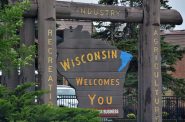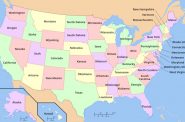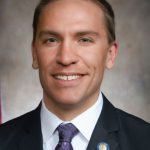WOW Counties Turning Less Republican
Ozaukee and Waukesha now less red while Washington County resists the trend.

Port Washington is the seat of Ozaukee County. File photo by John Uhrig (CC BY 2.0).
Traditionally, the political story of the Milwaukee area consisted of its strongly Democratic county bordered on two sides by three heavily Republican counties. These suburban counties—Waukesha, Ozaukee, and Washington, or the “WOW” counties—could be depended on to give at least two thirds of their votes to Republican candidates.
But over the 20-year span, the partisan mix of the three WOW counties diverged. The Democratic share of Washington County’s vote remained the same, while Democrats in Ozaukee and Waukesha counties increased their share of the vote.
Meanwhile, the Democratic share of the Milwaukee County vote also rose during this period—from 61% to 70%.
In the recent Wisconsin primary election, voters were asked to vote on two proposed amendments to the Wisconsin constitution. Both would have increased the power of the Legislature—or committees of the Legislature — to veto decisions of the executive.
The effect of the second of these is the easiest to project:
Allocation of federal moneys. Shall section 35 (2) of article IV of the constitution be created to prohibit the governor from allocating any federal moneys the governor accepts on behalf of the state without the approval of the legislature by joint resolution or as provided by legislative rule?
If it had passed, this would have given legislators a veto over the use of funds from the federal government. This was opposed by a large number of “good government” groups.
Among these was the League of Women Voters which argued :
When Wisconsin gets federal funds, it’s our tax money we paid to the IRS coming back to us. Don’t let the legislature create obstacles for our communities and play partisan games with our money. We can’t afford delays when crises and disasters strike.
The Wisconsin Democratic Party, and its local branches, took a major role in opposing both proposals. This is not surprising because they would have had the effect of increasing the power of the Republican Legislature over the Democratic governor.
While the effect of the second proposed constitutional amendment was clear—to give the legislature and its committees a veto over the use of federal grants, the implication of the first is less clear. Most of the articles discussing the amendment fell back on quoting its language:
Delegation of appropriation power. Shall section 35 (1) of article IV of the constitution be created to provide that the legislature may not delegate its sole power to determine how moneys shall be appropriated?
It appears to me that it aimed to give the Legislature, or its committees, an argument that they should be able to veto the actions of the executive. After all, most of the other funds used by Wisconsin government have been appropriated by the Legislature. In other words, this appears to be an attempt to circumvent the separation-of-powers principal.
The next graph shows the vote on the first proposed amendment. (The vote on the second is essentially the same.) As the first pair of columns confirms, voters in the August election rejected the amendment by a vote of 57% to 43%. The size of this margin is surprising. By scheduling the vote in a low-turnout election, the amendments’ supporters in the Legislature clearly expected to benefit from low turnout.
The following five columns show the vote in the city of Milwaukee, in the portion of Milwaukee County outside the city, Ozaukee County, Waukesha County, and Washington County. The relative sizes of support and opposition in each body look very similar to what one would expect in a partisan election. Opposition is strongest in Milwaukee, next strongest in the rest of Milwaukee County. It is essentially tied with support in Ozaukee County (there are only 70 more Yes votes than No votes). A majority in Waukesha County supported the amendments, which won by almost two to one in Washington County.
A word of caution is in order at this point. While support and opposition to the referendum is heavily correlated with votes for candidates from the two parties, one cannot take that as a predictor of results in the upcoming presidential election. For instance, it does not mean that Kamala Harris is assured of winning 57% of the votes in Wisconsin. Perhaps opponents of the amendments are more motivated than supporters or some number of people who normally vote for Republican candidates believe that the amendments are bad public policy.
The next graph tells a similar story. In the primary election, voters select the party primary in which they want to vote, so you can see the percentage who chose to vote in the Republican primary and the Democratic primary. As before, the Democratic percentage goes down as the distance from downtown Milwaukee goes up, and vice versa.
Again, one should be cautious in applying these results to a national election. Republican voters in Milwaukee may find that the only primaries are Democratic or those in Washington County may find that the only interesting primaries are Republican.
The overall pattern here is that the more rural a county the more likely it is to vote Republican. The same pattern also appears within counties. For example, consider the next graph which compares the percentage of No votes in towns to similarly named villages and cities in Ozaukee County. These result when the more organized part of a town decides to incorporate as a village or city, leaving the more rural part of the town. In only one of the six combinations did more voters vote No in the town than in the village or city.
The Milwaukee area is following the national trend in which close-in suburbs become increasingly Democratic, while more rural areas become more Republican. Though there are many theories on what is driving this trend, it still remains something of a mystery. But clearly the trend is changing two of the three WOW counties.
If you think stories like this are important, become a member of Urban Milwaukee and help support real, independent journalism. Plus you get some cool added benefits.
Data Wonk
-
Life Expectancy in Wisconsin vs. Other States
 Dec 10th, 2025 by Bruce Thompson
Dec 10th, 2025 by Bruce Thompson
-
How Republicans Opened the Door To Redistricting
 Nov 26th, 2025 by Bruce Thompson
Nov 26th, 2025 by Bruce Thompson
-
The Connection Between Life Expectancy, Poverty and Partisanship
 Nov 21st, 2025 by Bruce Thompson
Nov 21st, 2025 by Bruce Thompson


























As a centrist independent living in Waukesha County (Sussex), this is good news. I’m not necessarily saying I’ll always vote Blue, but I’ve got to say, to me there is no sane conservative party. The republican party has become a Christian national neo- fascist party that I really want no part of. Maybe the swing to a more 50/50 split will either bring out the more conservative (bi-partisan) democrats or tone down the radicalization of the republicans.
In the meantime, I’ll get my Harris sign out on the lawn to show all the trumpers in the neighborhood that not all of us are weird..
The “WOW” counties, or otherwise known as the WPBT (“White People Be Trippin”) counties.